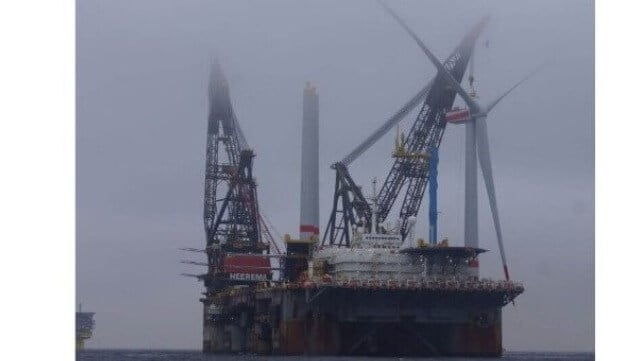Unique Floating Installation Method Used to Construct Wind Farm

For the first time, the construction of an offshore wind farm is being conducted using a floating installation method. Instead of using a traditional jack-up wind turbine installation vessel, which are in short supply and in high demand, the Arcadis Ost 1 in the Baltic will be assembled using a new method centered around a semi-submersible crane vessel.
According to the companies that developed this method in addition to addressing the shortage of WTIVs, it provides for a shorter installation cycle and requires no seabed interaction. They believe that this installation method promises to unlock the potential of many offshore areas around the world with challenging soil conditions.
The plan to use a floating installation method for Arcadis Ost 1 was announced for the first time in November 2019. After almost three years of development and engineering, Heerema Marine Contractors and Vestas working with Parkwind which is the developer of the wind farm, completed the installation of the first wind turbine using the new method. The first of the 27 Vestas V174 – 9.5MW turbines was installed at the Arcadis Ost 1 wind farm in late November.
“The floating installation method is the perfect example of what it takes to set new industry standards, and new standards mean new opportunities for offshore wind globally,” said Eric Antoons, co-CEO of Parkwind. “Arcadis Ost 1 will soon be one of the world’s most advanced wind farms, thanks to its design, components, and installation method.”
Heerema’s second largest semi-submersible crane vessel (SSCV) Thialf, built in 1985, is handling the unique installation process. The massive 661-foot vessel, which for many years was the largest of its kind, has two cranes with a lift capacity of 14,200 metric tons.
To speed up the installation process, assembly and lifting operations are happening in parallel. One of the Thialf’s two main cranes lifts the pre-assembled WTG tower to the foundation, while the second main crane is used to pre-assemble the WTG in parallel. Heerema developed a method where the rotor nacelle assembly (RNA) lift takes place on a so-called “support” tower on board of the crane vessel. The support tower provides a stable platform to allow a fast and secure assembly of the nacelle and the blades. Once pre-assembled the complete RNA is lifted as one piece onto the WTG tower in only one lift.
According to the companies, the pre-assembly process on board the Thialf ensures full control thereby guaranteeing a safe and highly reliable installation environment. The reduced number of lifts between the vessel and the structure eliminates key risks of the floating installation. Vestas has delivered RNA lift-feasible components by developing new tools to support the offshore floating installation.
“This first installation is the result of extensive engineering, innovation, and the dedication of our team, alongside Parkwind and Vestas, who together have worked hard to deliver the first floating installation of a wind turbine generator using our novel RNA method,” said Michel Hendriks, Chief Operating Officer of Heerema Marine Contractors. “This moment is a major milestone within the offshore wind industry, and Heerema will continue to develop and enhance our capabilities for the floating installation of offshore wind farms.”
The Arcadis Ost 1 is a 257 MW wind farm developed by Parkwind, located in the German territorial waters of the Baltic Sea, northeast of the island of Rügen. It is Europe’s first wind farm equipped with Vestas’ V174-9.5MW turbines and Parkwind’s first international project. The installation campaign started in June 2022 and the wind farm’s final commissioning is planned for 2023.
